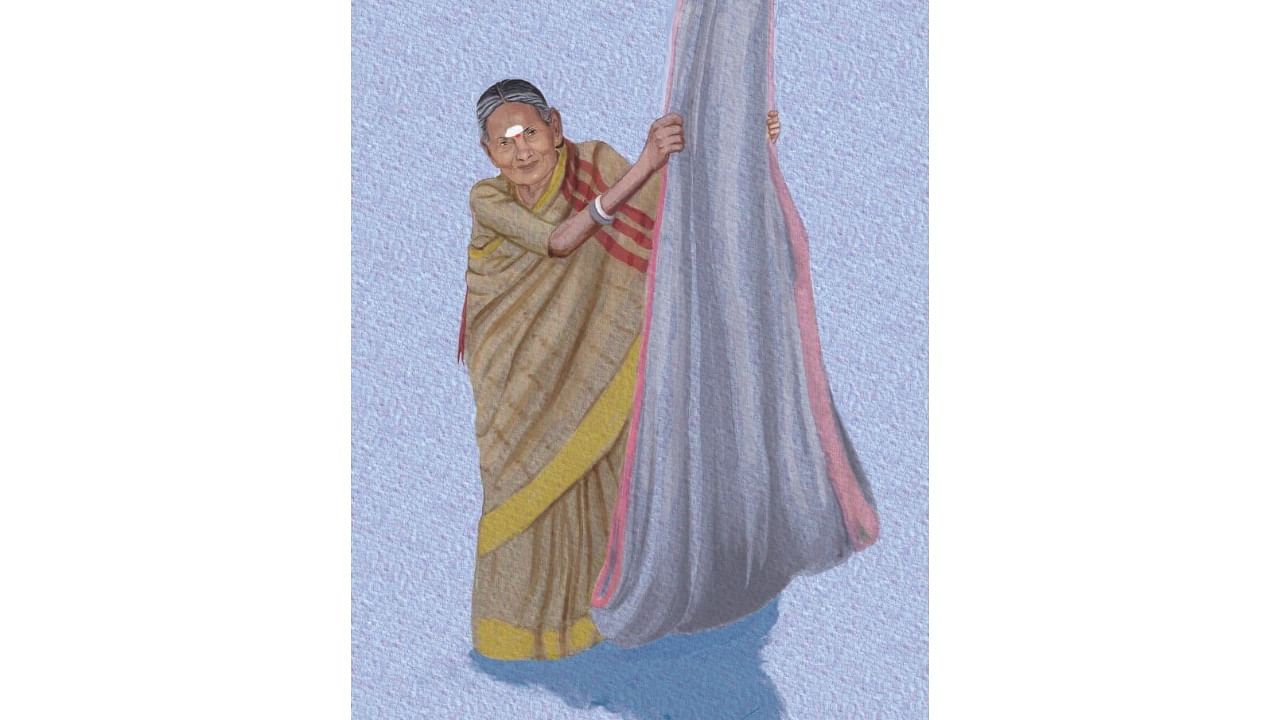
Sulagitti Narasamma.
Credit: Illustration/ Mistunee Chowdhury
India is a country of high birth mortality, which means that many babies die at the time of birth. Experts say that this is because good and safe healthcare does not reach all mothers and their soon-to-be-born children. In a country like ours, the role of a woman who single-handedly delivered over 15,000 babies is very important. This woman is Narasamma, popularly known as Sulagitti Narasamma.
Narasamma was born in 1920 in Pavagada village in Karnataka. She belonged to a nomadic tribe who were considered ‘untouchable’, that is, low caste. Hailing from a poor family, Narasamma did not get the chance to go to school. But from a young age, she was a keen observer and learner. Married at the tender age of twelve, Narasamma learnt the traditional art of delivering babies from her grandmother, Marigemma. Such knowledge was not commonly available. Marigemma delivered five of Narasamma’s children. It was at the age of twenty that Narasamma first helped deliver a baby, and she continued doing this work tirelessly for seven decades.
Narasamma’s work earned her the title ‘Sulagitti’, which is a Kannada word for midwife, or someone trained to assist women in childbirth. Why was her work important? In rural Karnataka, there were many villages and communities which were totally cut off from modern hospitals and doctors as well as roads. Hospital deliveries were not common in those days. Unassisted births were dangerous for the mother and the newborn baby. In these situations, Narasamma’s skill as a midwife saved many lives. While there were other midwives in the region, most women preferred her. Like her grandmother, she was considered special in her abilities. She had a talent for checking the pulse of the foetus and the position of its head without any instrument. Most of the women were poor like Sulagitti. So she did not take any money from them for her services. Instead, she considered herself a protector of these women. We do not know what motivated Sulagitti or why she, despite being poor herself, chose not to charge others. But it was clear that she was passionate about her work. And all through her long life, she continued this along with her work in the fields.
Narasamma was not satisfied with the basic midwifery skills that she’d developed. She wanted to learn more so that she could do her job better. She wanted to know how to keep babies healthy. She learned about natural remedies and traditional practices from the nomadic tribes who frequented her village. Her commitment was towards both the babies and their mothers. She made Ayurvedic medicine for new mothers to ease their pain or other difficulties after they had given birth. Her work shows how she successfully combined her natural skills with traditional knowledge and a scientific temper.
Narasamma served her community at a time when traditional midwives were discredited. The British government promoted allopathic medical practices and opposed the traditional profession of Indian midwives. They said that such women were illiterate and had no knowledge about allopathic medicine. The educated middle class claimed that rural midwives were almost like witches who caused babies to die. It is true that sometimes the label of indigenousness or tradition is used to pass off superstitions and unscientific — even dangerous — methods as knowledge. That is why practitioners of modern science often distrust indigenous knowledge systems. But the kind of work Narasamma did in delivering babies and looking after new mothers was not altogether different from the foundations of modern science. It was also based on the same scientific understanding of the human body and of birth. These practices were based on generations of knowledge that women from a nomadic culture had acquired, not from magic and superstition, but from close observation of nature and animals, and ecology and humans. At this juncture in history, Narasamma’s work was of immense importance. In remote areas with no hospitals or doctors, and mostly poor people and a lack of midwives, her skill and knowledge helped in reducing infant mortality. Her selfless work helped in creating alternative avenues of childbirth. In 2018, at the age of ninety-two, Narasamma died of a lung infection. Her faith in traditional knowledge and natural remedies was not unscientific. Sulagitti Narasamma’s work has now been recognised through multiple awards, including a Padma Shri.
(Excerpted with permission from A Star Named Bibha and Other Stories by Anwesha Sengupta, Simantini Mukhopadhyay and Supurna Banerjee, published by HarperCollins India.)